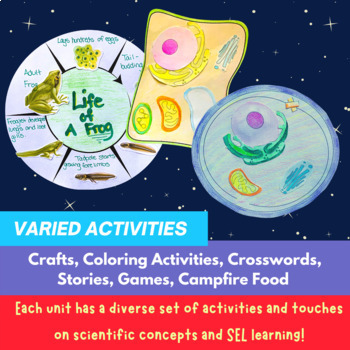Science Camp Activities | Camping Games | Experiments | Life Skills | Summer
- Zip
- Easel Activity

Products in this Bundle (13)
showing 1-5 of 13 products
Bonus
Description
Summer Science Camp - 23 activities - Experiments, Crafts, Coloring, Lesson Plan
Learn important life skills and STEM lessons with the Campfire Science Camp. Our workbooks are filled with camping activities that diverse range from experiments, science crafts, coloring activities, experiments. There are 23 activities in total in this bundle as well as a certificate of excellence for completion and a badge for each unit of the camp. The lesson plan includes units named nature lover, astronomy, amphibians, and Campfire safety. The activity is perfect for elementary and middle school campers.
The booklet comes in black and white and color
This lesson plan contains:
Video instructions for each unit
Editable Certificate of Achievements
Badge System
3 Coloring Activities
3 Presentations ( 50 Slides Total )
3 Experiments and infographics
3 Crafts
3 Worksheets that focus on campfire recipes, and games
1 Art Project and Social-emotional Learning Activity
Booklets
- Instructor workbook that comes with everything colored in
- Black and White workbook for students handout
Award Systems!
- Editable Certificate of Achievement (Names, Titles)
- 4 Badges for each unit and a handout for students badge wallet
Campfire Safety Unit
- The Science Of Campfires
- Campfire Terminology
- Teepee Fire Instructions
- Campfire Recipes - S'mores and Banana Boats
- Camp Fireworks Experiment
- Safety Drawing and Coloring Activity
Nature Lover Unit (2 Powerpoint Lessons)
- Photosynthesis Diagram and coloring activity
- Build a Plant Cell Craft and Lesson
- Build an Animal Cell Craft and Lesson
- Nature Scavenger Hunt - SEL activity
- Nature Portrait - Art Project
Astronomy Unit
- Camping Storytime Worksheet
- Planets in the Solar System Coloring Activity
- Planets in the Solar System Poster
- Bottle Rocket Experiment
- Camping Games Handout
Amphibian Unit (1 Lesson)
- Frog Lesson Slides
- Frog Digital and Printable Worksheet
- Frog Life Cycle Craft
- Elastic Powered Boat Experiment
Extras
- Review Science Camp Crossword





